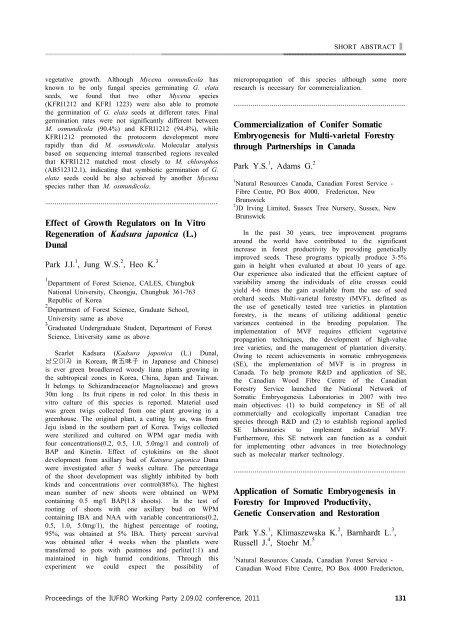Advances in Somatic embryogenesis of Trees and Its - IUFRO
Advances in Somatic embryogenesis of Trees and Its - IUFRO
Advances in Somatic embryogenesis of Trees and Its - IUFRO
Create successful ePaper yourself
Turn your PDF publications into a flip-book with our unique Google optimized e-Paper software.
SHORT ABSTRACT <br />
<br />
vegetative growth. Although Mycena osmundicola has<br />
known to be only fungal species germ<strong>in</strong>at<strong>in</strong>g G. elata<br />
seeds, we found that two other Mycena species<br />
(KFRI1212 <strong>and</strong> KFRI 1223) were also able to promote<br />
the germ<strong>in</strong>ation <strong>of</strong> G. elata seeds at different rates. F<strong>in</strong>al<br />
germ<strong>in</strong>ation rates were not significantly different between<br />
M. osmundicola (90.4%) <strong>and</strong> KFRI1212 (94.4%), while<br />
KFRI1212 promoted the protocorm development more<br />
rapidly than did M. osmundicola. Molecular analysis<br />
based on sequenc<strong>in</strong>g <strong>in</strong>ternal transcribed regions revealed<br />
that KFRI1212 matched most closely to M. chlorophos<br />
(AB512312.1), <strong>in</strong>dicat<strong>in</strong>g that symbiotic germ<strong>in</strong>ation <strong>of</strong> G.<br />
elata seeds could be also achieved by another Mycena<br />
species rather than M. osmundicola.<br />
··························································································<br />
Effect <strong>of</strong> Growth Regulators on In Vitro<br />
Regeneration <strong>of</strong> Kadsura japonica (L.)<br />
Dunal<br />
Park J.I. 1 , Jung W.S. 2 , Heo K. 3<br />
1 Department <strong>of</strong> Forest Science, CALES, Chungbuk<br />
National University, Cheongju, Chungbuk 361-763<br />
Republic <strong>of</strong> Korea<br />
2 Department <strong>of</strong> Forest Science, Graduate School,<br />
University same as above<br />
3 Graduated Undergraduate Student, Department <strong>of</strong> Forest<br />
Science, University same as above<br />
Scarlet Kadsura (Kadsura japonica (L.) Dunal,<br />
<strong>in</strong> Korean, <strong>in</strong> Japanese <strong>and</strong> Ch<strong>in</strong>ese)<br />
is ever green broadleaved woody liana plants grow<strong>in</strong>g <strong>in</strong><br />
the subtropical zones <strong>in</strong> Korea, Ch<strong>in</strong>a, Japan <strong>and</strong> Taiwan.<br />
It belongs to Schiz<strong>and</strong>raceae(or Magnoliaceae) <strong>and</strong> grows<br />
30m long . <strong>Its</strong> fruit ripens <strong>in</strong> red color. In this thesis <strong>in</strong><br />
vitro culture <strong>of</strong> this species is reported. Material used<br />
was green twigs collected from one plant grow<strong>in</strong>g <strong>in</strong> a<br />
greenhouse. The orig<strong>in</strong>al plant, a cutt<strong>in</strong>g by us, was from<br />
Jeju isl<strong>and</strong> <strong>in</strong> the southern part <strong>of</strong> Korea. Twigs collected<br />
were sterilized <strong>and</strong> cultured on WPM agar media with<br />
four concentrations(0.2, 0.5, 1.0, 5.0mg/1 <strong>and</strong> control) <strong>of</strong><br />
BAP <strong>and</strong> K<strong>in</strong>et<strong>in</strong>. Effect <strong>of</strong> cytok<strong>in</strong><strong>in</strong>s on the shoot<br />
development from axillary bud <strong>of</strong> Katsura japonica Duna<br />
were <strong>in</strong>vestigated after 5 weeks culture. The percentage<br />
<strong>of</strong> the shoot development was slightly <strong>in</strong>hibited by both<br />
k<strong>in</strong>ds <strong>and</strong> concentrations over control(88%). The highest<br />
mean number <strong>of</strong> new shoots were obta<strong>in</strong>ed on WPM<br />
conta<strong>in</strong><strong>in</strong>g 0.5 mg/l BAP(1.8 shoots). In the test <strong>of</strong><br />
root<strong>in</strong>g <strong>of</strong> shoots with one axillary bud on WPM<br />
conta<strong>in</strong><strong>in</strong>g IBA <strong>and</strong> NAA with variable concentrations(0.2,<br />
0.5, 1.0, 5.0mg/1), the highest percentage <strong>of</strong> root<strong>in</strong>g,<br />
95%, was obta<strong>in</strong>ed at 5% IBA. Thirty percent survival<br />
was obta<strong>in</strong>ed after 4 weeks when the plantlets were<br />
transferred to pots with peatmoss <strong>and</strong> perlite(1:1) <strong>and</strong><br />
ma<strong>in</strong>ta<strong>in</strong>ed <strong>in</strong> high humid conditions. Through this<br />
experiment we could expect the possibility <strong>of</strong><br />
micropropagation <strong>of</strong> this species although some more<br />
research is necessary for commercialization.<br />
··························································································<br />
Commercialization <strong>of</strong> Conifer <strong>Somatic</strong><br />
Embryogenesis for Multi-varietal Forestry<br />
through Partnerships <strong>in</strong> Canada<br />
Park Y.S. 1 , Adams G. 2<br />
1 Natural Resources Canada, Canadian Forest Service -<br />
Fibre Centre, PO Box 4000, Fredericton, New<br />
Brunswick<br />
2 JD Irv<strong>in</strong>g Limited, Sussex Tree Nursery, Sussex, New<br />
Brunswick<br />
In the past 30 years, tree improvement programs<br />
around the world have contributed to the significant<br />
<strong>in</strong>crease <strong>in</strong> forest productivity by provid<strong>in</strong>g genetically<br />
improved seeds. These programs typically produce 3-5%<br />
ga<strong>in</strong> <strong>in</strong> height when evaluated at about 10 years <strong>of</strong> age.<br />
Our experience also <strong>in</strong>dicated that the efficient capture <strong>of</strong><br />
variability among the <strong>in</strong>dividuals <strong>of</strong> elite crosses could<br />
yield 4-6 times the ga<strong>in</strong> available from the use <strong>of</strong> seed<br />
orchard seeds. Multi-varietal forestry (MVF), def<strong>in</strong>ed as<br />
the use <strong>of</strong> genetically tested tree varieties <strong>in</strong> plantation<br />
forestry, is the means <strong>of</strong> utiliz<strong>in</strong>g additional genetic<br />
variances conta<strong>in</strong>ed <strong>in</strong> the breed<strong>in</strong>g population. The<br />
implementation <strong>of</strong> MVF requires efficient vegetative<br />
propagation techniques, the development <strong>of</strong> high-value<br />
tree varieties, <strong>and</strong> the management <strong>of</strong> plantation diversity.<br />
Ow<strong>in</strong>g to recent achievements <strong>in</strong> somatic <strong>embryogenesis</strong><br />
(SE), the implementation <strong>of</strong> MVF is <strong>in</strong> progress <strong>in</strong><br />
Canada. To help promote R&D <strong>and</strong> application <strong>of</strong> SE,<br />
the Canadian Wood Fibre Centre <strong>of</strong> the Canadian<br />
Forestry Service launched the National Network <strong>of</strong><br />
<strong>Somatic</strong> Embryogenesis Laboratories <strong>in</strong> 2007 with two<br />
ma<strong>in</strong> objectives: (1) to build competency <strong>in</strong> SE <strong>of</strong> all<br />
commercially <strong>and</strong> ecologically important Canadian tree<br />
species through R&D <strong>and</strong> (2) to establish regional applied<br />
SE laboratories to implement <strong>in</strong>dustrial MVF.<br />
Furthermore, this SE network can function as a conduit<br />
for implement<strong>in</strong>g other advances <strong>in</strong> tree biotechnology<br />
such as molecular marker technology.<br />
··························································································<br />
Application <strong>of</strong> <strong>Somatic</strong> Embryogenesis <strong>in</strong><br />
Forestry for Improved Productivity,<br />
Genetic Conservation <strong>and</strong> Restoration<br />
Park Y.S. 1 , Klimaszewska K. 2 , Barnhardt L. 3 ,<br />
Russell J. 4 , Stoehr M. 5<br />
1 Natural Resources Canada, Canadian Forest Service -<br />
Canadian Wood Fibre Centre, PO Box 4000 Fredericton,


